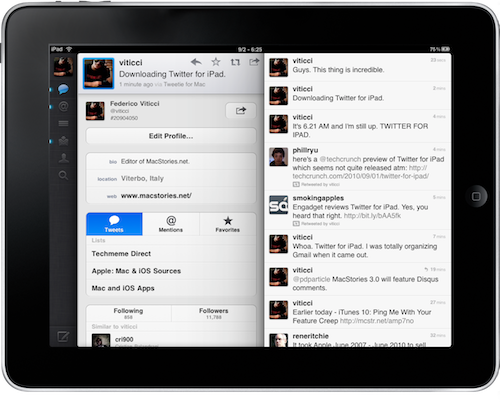Twitter for iPad came out two weeks ago and everyone’s still talking about it. Well, at least everyone in the Twitter / iOS-related sphere. Why? Because it breaks standards and, at the same time, creates new ones which are going to deeply affect the way we think of native applications for iPad. In a way, I think Loren Brichter managed to reinvent the whole Twitter wheel on Apple’s magical tablet, but I’ve already written a blog post about this. I’m not here to re-celebrate the innovations of Twitter for iPad. Instead, I’d like to focus on the impact that this app had (and is having) on 3rd party clients, from a casual user and geek perspective.
I don’t care about sales (but of course developers do), I just want to consider whether Twitter for iPad really raised the bar or not. And most of all, what are developers doing to catch up?
Usually, my best advice would be: don’t change. If someone else is getting popular because of a particular feature, don’t try to copy it. But there’s copy and there’s adoption of new standards. When Brichter implemented the “pull to refresh” gesture in Tweetie 2 for iPhone, hundreds of developers followed and implemented the same exact thing in their apps. Someone even created an open source version of the feature, which Facebook is now using in their iPhone client. Was that copying someone else’s invention? No. It was a change for the better. I like to think that sometimes 3rd party developers can come up with new platform-wide features instead of Apple. Pull to refresh was the perfect example. Developers who implemented it credited Brichter, but it was more of a forced (yet welcome) change.
Panels. Are panels the new pull to refresh? Maybe. Maybe it’s just a gimmick we’ll grow tired of in a matter of months, but I don’t think so. I think that Loren’s new implementation of how Twitter should be enjoyed on the iPad is genius. It relies on the device’s larger screen to let you stack panels on top of each other, without being forced to constantly change view and hit buttons to open / close. It’s the love child of Tweetie for Mac and Tweetie 2 for iPhone. To those who after 2 weeks are still complaining about bugs: chill. A new update with many fixes is due to come out soon, so don’t sweat over some issues with the sidebar and multi-touch gestures. The truth is, you can’t deny Brichter introduced something new that puts old concepts of using Twitter on the iPad to shame. Once you see Twitter for iPad, you realize that’s the way to go. Think about it: Twitterrific, Osfoora and Twitbird are all based on iPhone navigation schemes ported to the iPad. Ok, Twitterrific’s popovers are great and I like Osfoora’s landscape view. But the timeline interaction, that’s the same all over again. Twitter for iPad breaks this convention.
Third party clients will always have their own market and happy userbase. Will they have the visibility of Twitter for iPad from now on, though? Surely not. If the developers of Osfoora and Twitterrific (the most popular Twitter clients for iPad) want to make people and bloggers talk about them again, they better show us what they got.
That old way of consuming Twitter is dead. Progress killed it.
Now, it’s totally your call whether you want to stick with more familiar interfaces or not. But you have to admit Brichter is good at this “let’s reinvent Twitter” thing. You have to.


